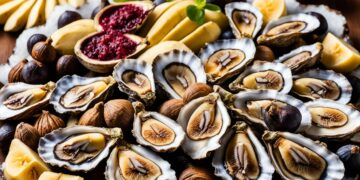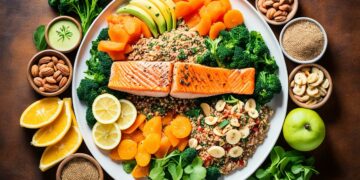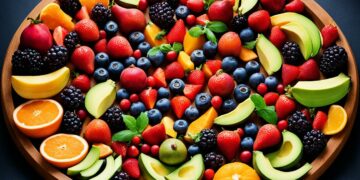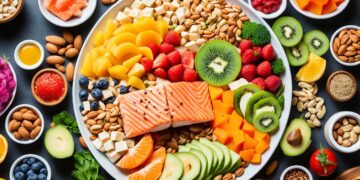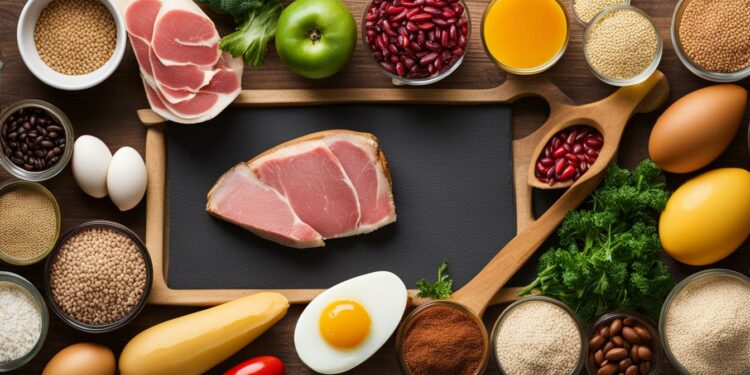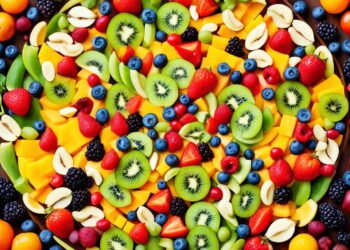Did you know that protein is an essential nutrient that plays a crucial role in various bodily functions? It helps build and repair tissues, supports the immune system, and aids in muscle growth and recovery.
However, not all sources of protein are created equal. Some protein sources provide more nutritional benefits than others and can have a significant impact on your overall health.
In this article, we will explore the best and worst sources of protein based on factual data from multiple sources. By understanding the ranking of protein sources, you can make informed choices for a balanced diet that supports your overall well-being.
Key Takeaways:
- Protein is an essential nutrient that plays a crucial role in various bodily functions.
- Not all sources of protein are created equal.
- Some protein sources provide more nutritional benefits than others.
- Understanding the ranking of protein sources can help you make informed choices for a balanced diet.
- By prioritizing healthy protein choices and avoiding unhealthy options, you can achieve a protein-rich diet that supports your overall well-being.
Healthiest Sources of Protein
When it comes to selecting the healthiest sources of protein, there are several options that stand out. These include chicken breast, eggs, salmon, nuts and seeds, and beans and legumes.
Chicken breast is a popular choice as it is low in fat and provides a good amount of protein. It is a lean protein option that can be easily incorporated into meals.
Eggs are a complete protein and are packed with essential nutrients. They are also versatile and can be enjoyed in various forms, such as scrambled, boiled, or in omelets.
Salmon is not only a great source of protein but also contains beneficial omega-3 fatty acids. These healthy fats have been linked to heart health and brain function. Including salmon in your diet can provide both protein and essential nutrients.
Nuts and seeds are versatile protein sources that also offer fiber, healthy fats, vitamins, and minerals. Almonds, walnuts, chia seeds, and flaxseeds are excellent choices that can be enjoyed as snacks or added to meals and desserts.
Beans and legumes are ideal for vegans and vegetarians, providing a good amount of protein along with other nutrients like fiber and vitamins. Examples include lentils, chickpeas, black beans, and kidney beans.
When selecting protein-rich foods, it’s important to consider not only the protein content but also the overall nutritional value they offer. Incorporating these healthy protein sources into your diet can contribute to optimal protein selection and support a balanced and nutritious eating pattern.
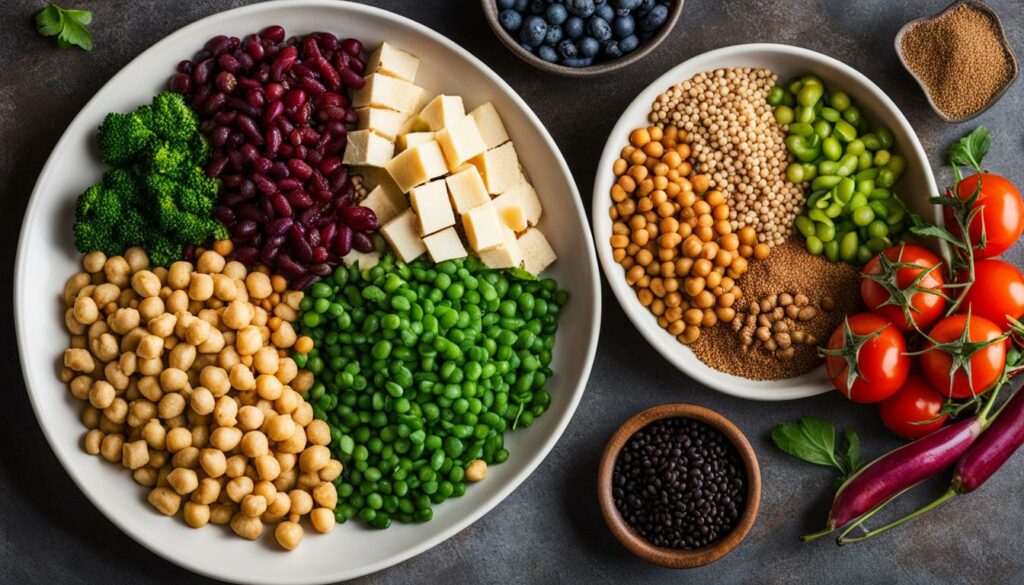
Unhealthy Sources of Protein
While protein is essential for our bodies, not all sources of protein are created equal. It’s important to be mindful of unhealthy options to make informed choices for a balanced diet. Here are some examples of unhealthy sources of protein:
- Processed Meats: Hot dogs, bacon, and sausages are popular examples of processed meats that are high in saturated fat and sodium. Consumption of these meats has been linked to an increased risk of diseases like colorectal cancer.
- Grain-fed Red Meats: Beef, pork, and lamb that come from grain-fed animals tend to be high in saturated fat. Additionally, the process of grain feeding livestock has negative environmental impacts.
- Low-quality Protein Powders: Some protein powders may contain added sugar, preservatives, and fillers, making them a less healthy option for getting protein in your diet.
- Dairy Products: While dairy products like cheese are a source of protein, they can contribute to weight gain due to their high saturated fat content. Moderation is key when consuming these products.
To make healthier choices, consider alternatives such as lean cuts of meat, poultry, fish, eggs, legumes, and plant-based protein sources. It’s important to prioritize high-quality protein options for better overall health and well-being.

Best and Worst Sources of Protein: Yogurt and Fish
In the quest for protein-rich foods, it’s important to consider both the best and worst sources available. Greek yogurt and fish are two options that fall on opposite ends of the spectrum when it comes to their nutritional profiles.
Greek Yogurt: A Healthy Choice
When it comes to specific protein sources, Greek yogurt stands out as an excellent choice. Not only does it provide a significant amount of protein, but it is also low in sugar and contains beneficial probiotics.
These probiotics support gut health and enhance digestion, making Greek yogurt a wholesome and beneficial addition to your diet.
One key advantage of Greek yogurt is its versatility. It can be enjoyed on its own, added to smoothies, or used as a base for savory dips and sauces. With a creamy texture and a tangy flavor, it is a satisfying and nutritious option for those seeking a protein-rich snack or meal.
Plant-Based Yogurt: Beware of Protein Content
While Greek yogurt is a top contender in the protein department, plant-based yogurts may not offer the same protein punch. Many plant-based yogurts have lower protein content and may contain additives and sweeteners.
It’s important to carefully read the labels and choose plant-based yogurts that are fortified with additional nutrients to make up for any protein deficiencies.
Other Notable Protein Sources
While yogurt is a popular protein option, there are other sources that deserve recognition. Eggs, for example, are a convenient and versatile protein source that provides high-quality protein along with essential vitamins and minerals.
Eggs can be cooked in various ways, making them a go-to ingredient for breakfast, lunch, or dinner.
On the other hand, red meat, such as beef, pork, and lamb, is high in protein but comes with potential health risks and environmental concerns. Processed red meats, like hard salami, should be limited due to their high fat, sodium, and calorie content.
Opting for lean cuts of red meat or replacing it with alternative protein sources can be a healthier choice for individuals concerned about their well-being.
Wild salmon is another standout protein source. It not only provides a significant amount of protein but also contains heart-healthy omega-3 fatty acids. These fatty acids offer numerous health benefits, including reducing inflammation and promoting brain health.
Incorporating wild salmon into your diet can be an excellent way to meet your protein needs while promoting overall well-being.
Overall, when it comes to protein sources, choosing Greek yogurt and wild salmon can provide you with the nutritional advantages of protein-rich foods. On the other hand, plant-based yogurt and hard salami may fall short in terms of protein content and overall health benefits.
Conclusion
Ensuring optimal protein intake is essential for maintaining a healthy and balanced diet. By making informed choices about protein sources, you can prioritize your well-being and support your body’s needs.
Incorporating healthy protein choices such as chicken breast, eggs, salmon, nuts and seeds, and beans and legumes can provide you with the necessary protein and vital nutrients your body requires.
However, it is equally important to avoid unhealthy protein sources that can have negative effects on your health. Stay away from processed meats like hot dogs and sausages, which are high in saturated fat and sodium.
Grain-fed red meats should also be limited due to their negative environmental impact and high saturated fat content. Additionally, be cautious of low-quality protein powders that may contain added sugars and preservatives.
By following a protein-rich diet and focusing on healthy protein choices, you can achieve optimal well-being. Prioritize chicken breast, eggs, salmon, nuts and seeds, and beans and legumes as they provide not only protein but also essential vitamins, minerals, and beneficial fats.
Avoid processed meats, grain-fed red meats, and low-quality protein powders. By selecting the right protein sources, you can empower yourself to live a healthier and more fulfilling lifestyle.
FAQ
What are the best sources of protein?
The best sources of protein include chicken breast, eggs, salmon, nuts and seeds, and beans and legumes.
Why are these protein sources considered the best?
These protein sources are considered the best because they are low in fat, provide a good amount of protein, and also offer other essential nutrients.
What are some examples of unhealthy sources of protein?
Unhealthy sources of protein include processed meats like hot dogs, bacon, and sausages, grain-fed red meats like beef, pork, and lamb, low-quality protein powders, and excessive consumption of dairy products.
Why should I avoid unhealthy sources of protein?
Unhealthy sources of protein often contain high amounts of saturated fat, sodium, added sugars, and preservatives, which can increase the risk of certain diseases and contribute to weight gain.
Are all protein sources equally beneficial?
No, all protein sources are not equally beneficial. Some sources provide higher-quality protein and additional nutrients compared to others.
Can I get enough protein from plant-based sources?
Yes, you can get enough protein from plant-based sources like beans, legumes, nuts, and seeds. These sources also offer fiber and other essential nutrients.
What are some healthy alternatives to processed meats?
Healthy alternatives to processed meats include lean cuts of chicken, turkey, and fish, as well as plant-based protein options like tofu and tempeh.
Is Greek yogurt a good source of protein?
Yes, Greek yogurt is a good source of protein. It is high in protein, low in sugar, and also contains beneficial probiotics.
Can I consume red meat as a source of protein?
While red meat can provide protein, it is important to be mindful of the potential health risks associated with excessive consumption of grain-fed red meats. Lean cuts of red meat can be consumed in moderation as part of a balanced diet.
What are some protein-rich fish options?
Wild salmon is an excellent protein-rich fish option. It not only provides protein but also contains heart-healthy omega-3 fatty acids. However, hard salami is a less optimal protein choice due to its high fat, sodium, and calorie content.


